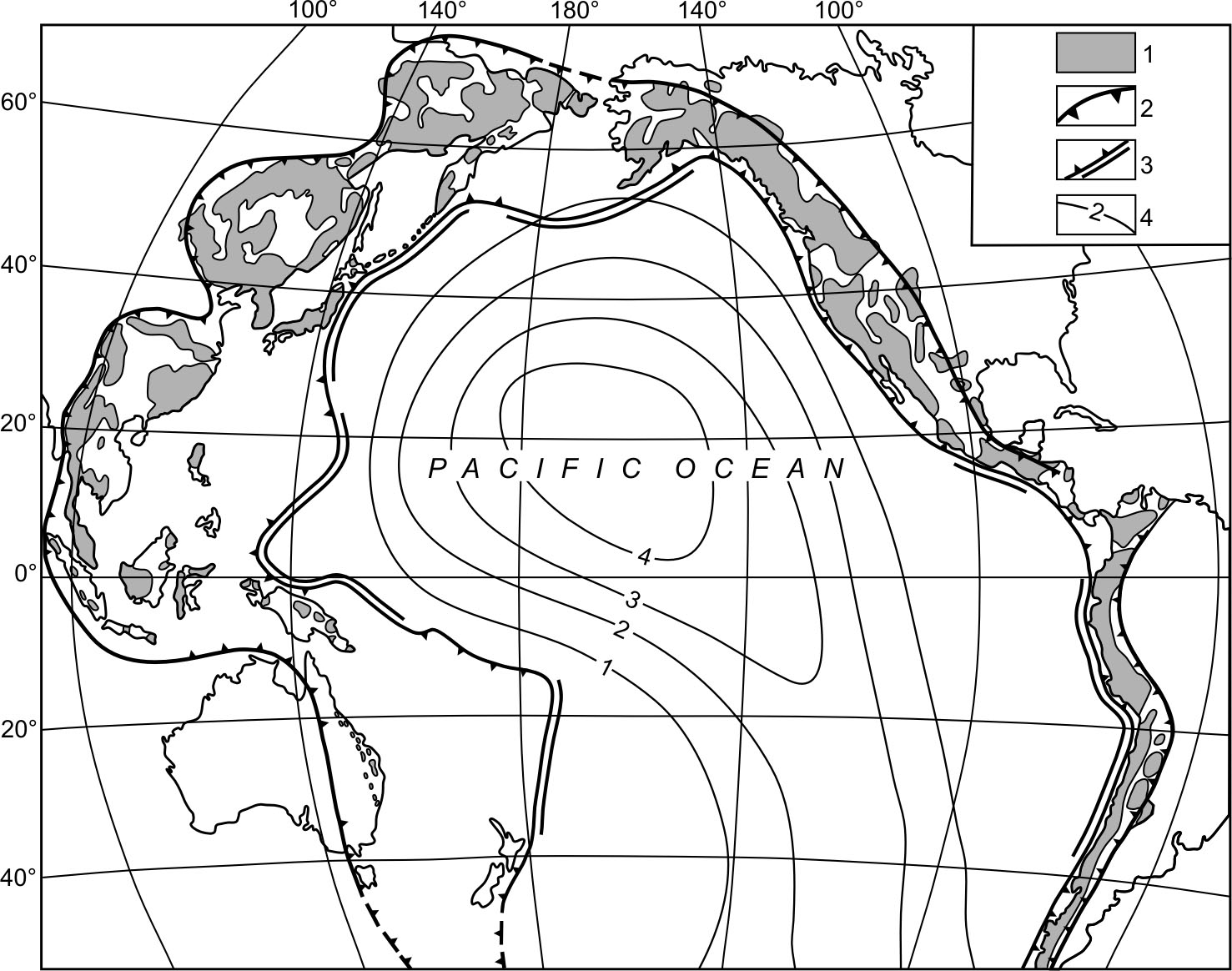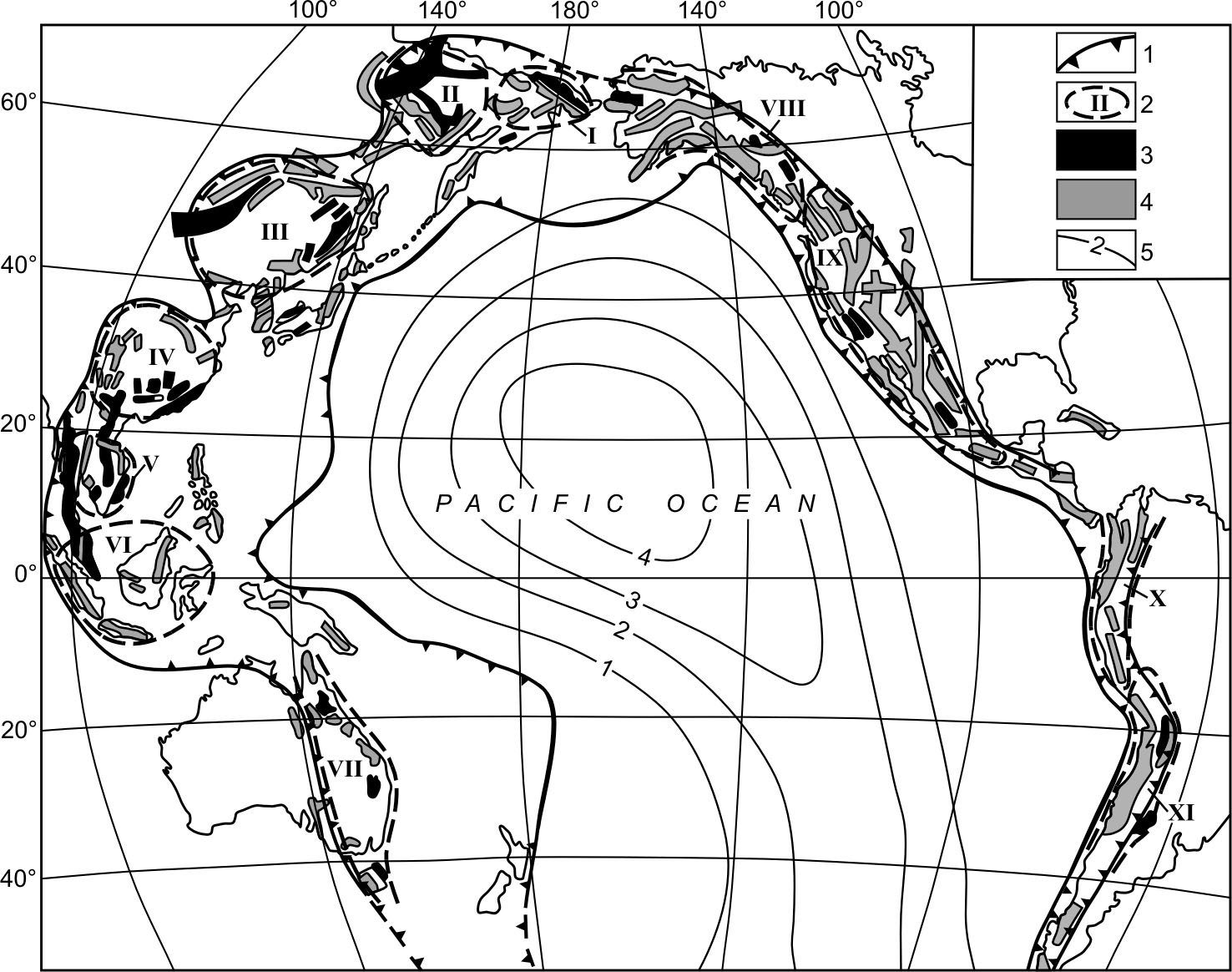|
GEOLOGICAL AND GEOPHYSICAL CHARACTERISTICS AND GEODYNAMICS OF GRANITOID ORE-MAGMATIC SYSTEMS OF THE PACIFIC BELT Yu. A. Kosygin Institute of Tectonics and Geophysics FEB RAS, Khabarovsk, Russia, itig@itig.as.khb.ru Mesozoic-Cenozoic granitoids and comagmatic volcanic rocks are exceedingly widespread in the outer (continental) part of the Pacific Ore Belt (POB). Under granitoids we imply the rocks ranging from quartz diorites to leucocratic granites and their alkaline varieties. They are represented either by prominent massifs (batholiths) or small-size stocks and dykes. Extensiveness of manifestation of granitoid magmatism is shown in Fig. 1 by areas where intrusions are not subdivided according to the composition and age. Quantitative data are derived from the Geological Map (1973) providing 2000 elementary cells of 1ох1о size for the Asian segment of the belt and 1400 cells for the American one. Each area location is bordered by an isoline showing the granitoid concentration as high as 5%. Development of endogenic mineralization associated with granitoid magmatism is notable for polycyclicity. Different authors distinguish from 3 to 7 epochs of intense ore formation. The major of these are Triassic - Early Jurassic, Late Jurassic - Early Cretaceous, Late Cretaceous – Paleogene and Neogene. Characteristic metals are represented by tin and tungsten (lithophile type), gold, silver, copper, molybdenum and polymetals (chalcophile type). The analysis of a complicated set of granitoid ore-magmatic systems (OMS) at different taxonomic levels shows that no less than 80% of the ore objects are attributable to the areas of Mesozoic-Cenozoic granitoid magmatism (Fig. 1 and 2).
Fig. 1. Areas of Mesozoic-Cenozoic granitoids of the Pacific Ore Belt. 1 – borders of areas with granitoid concentration of more than 5%; 2 – POB boundaries; 3 – subduction zones; 4 – relief of the Earth’s core – lower mantle boundary (km).
Geodynamics of the formation of OMS attributed to POB for the taxons of the planetary (segments of the belt) and super regional (metallogenic provinces) classes differs from those for the regional classes (metallogenic zones, ore regions). In the first case these are relations of oversubduction type, the transform, active or passive continental margins, more rarely those of the collisional type. In the second case, geodynamic environments of the collisional, intraplate, island-arc, oversubduction and active continental margin types are more often displayed (Geodynamics…, 2006). Granitoid OMS are formed at the intracrustal level and, as a rule, possess deep mantle-asthenosphere roots with increased tectonic and energy activity. In opinion of the authors (Dobretsov et al., 2001), in this situation mantle plumes play a significant role, originating at three levels of the geosphere: the upper mantle, the lower-upper mantle boundary, and the Earth’s core - lower mantle boundary. Probably, the plumes appearing at the Earth’s core - lower mantle boundary are of prime importance. “Bulges” at the surface of this boundary attain to 10-20 km high and can serve as sources of detachment of light volatile components of the liquid Earth’s core with their further transfer and transformation at higher levels of the geosphere. Figs 1 and 2 show the positive anomaly of the Earth’s core – lower mantle boundary (Morelli, Dziewonski, 1990). The marginal parts of the anomaly behave as if “diving” beneath the Asian and American segments of the belt, “pushing” them away from one another. It is not expelled that it is just within the bounds of this anomaly that more local and contrasting bulges appeared at the surface of the liquid Earth’s core. They could be responsible for the formation of deep plume systems including the most prominent of the known plumes – the Pacific one (Dobretsov et al., 2001).
Fig. 2. Sketch-map of metallogenic zone locations (Radkevich, 1977) of the granitoid ore-magmatic systems of the Pacific Belt (Romanovskii , 1999). 1.Boundaries of the Pacific Ore Belt; 2. Ore-magmatic systems: I – Chukotka, II – Yano-Kolyma, III – Amur, IV – East China, V – Mekong, VI – Malaysia, VII – East Australia, VIII – Canada-Alaska, IX – Central America, X - Peru-Columbia, XI – Chile-Bolivia; 3-4. Metallogenic zones: lithophile type (3), chalcophile type (4), 5 – relief of the Earth’s core – lower mantle boundary (km).
Geological-geophysical characteristics of the Asian and American segments of POB are significantly different in a number of cases. The OMS of the Asian segment are noted for the attributiveness to mount ranges with different orientation and average heights reaching 1-1.5 km and the maximum ones attaining to 3-5 km. They are more often observed as isometric regional minima of the Bouguer anomalies; a depth of the lower boundaries of such unconsolidation zones is 20-85 km. A minimum VP value at the Moho boundary is 7.8-8.0 km/s. Petromagnetic characteristic and the oxidation coefficient of iron differ sharply from area to area. The ilmenite rocks predominate in the OMS. Morphology of the super regional OMS is more often of the central type. For the OMS of the American segment it is typical their attributiveness to the major Andean and Cordilleras orogenic systems and the controlling influence of the extended Bouguer minima. A depth of the lower boundaries in the unconsolidation zones reaches 160-500 km. Minimum VP values at the Moho boundary are 4.7-7.8 km/s. The lower boundaries of the granitoid batholiths attain to 15-17 km. The petromagnetic characteristics and oxidation coefficient are more often stably high. The magnetite rocks predominate in the OMS. Morphology of the super regional OMS is more often of the linear type. It is suggested that this is related to more intense release of deep stresses concentrated in the narrow (100-200 km) Pacific and American mega structures junction zone, as compared to a wider (600-1500 km) Pacific and Asian mega structures junction zone. It is not excluded that due to rotational character of mobility of megablocks the compressional regimes were predominant in the American segment of the belt and the extensional ones – in the Asian segment of the belt.
References Dobretsov N.L., Kirdyuashkin A.G., Kirdyuashkin A.A. Deep Geodynamics // Novosibirsk: SO RAN, 2001. 406p. (in Russian). Geodynamics, magmatism and metallogeny of the East of Russia // Vladivostok: Dalnauka, 2006. Book 1. P. 230-500. (in Russian). Geological Map of the Pacific Mobile Belt and the Pacific Ocean // L.: Mingeo SSSR, 1973. 9 sheets. (in Russian). Morelli A., Dziewonski A. Harmonic decomposition method in the study of the deep structure of the Earth // Seismic Tomography. M.: 1990. P.264-285. (Russian translation). Radkevich E.A. Metallogenic provinces of the Pacific Ore Belt // M.: Nauka, 1977. 176p. (in Russian). Romanovskii N.P. Pacific segment of the Earth: deep structure, granitoid ore-magmatic systems // Khabarovsk: DVO RAN, 1999. 166p. (in Russian).
|

